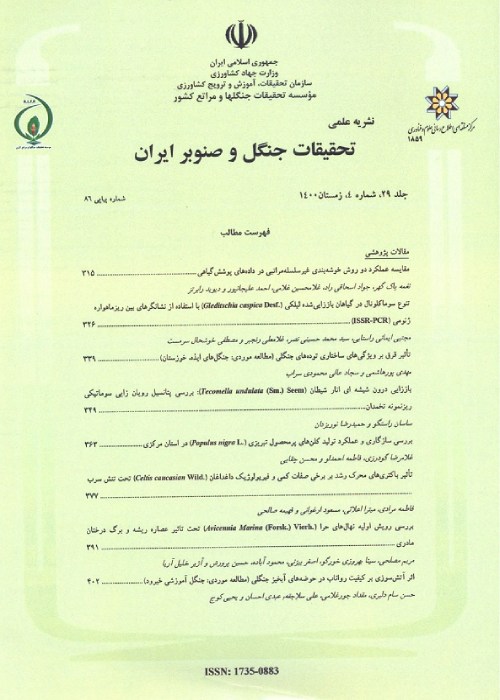Soil bioengineering in Iran: Lessons from the past and prospects for the future
Author(s):
Article Type:
Research/Original Article (دارای رتبه معتبر)
Abstract:
Background and objectives
Soil bioengineering techniques offer multifaceted benefits and find applications across diverse landscapes. These approaches are notable for their high sustainability, adaptability to environmental changes, and effective reestablishment. While existing bioengineering studies focus largely on assessing root systems for soil stabilization, it remains pivotal to estimate key biotechnical characteristics, such as root distribution and mechanical strength, for various plant species. These insights serve as crucial inputs for developing robust soil reinforcement models.Methodology
Root system distribution and mechanical strength data are integral for accurate reinforcement estimation. In Iran, conventional methods such as profile trenching and soil core sampling were employed for destructive sampling to investigate root system distribution and density. This focused on several tree species, including Fagus orientalis Lipsky, Carpinus betulus L., Alnus glutinosa (L.) Gaertn., Acer velutinum Boiss., Quercus castaneifolia C.A.Mey., Parrotia persica (DC.) C.A.Mey., Fraxinus excelsior L., Picea abies (L.) H.Karst., Quercus brantii Lindl., Quercus libani Oliv., Haloxylon persicum Bunge ex Boiss. & Buhse, Salix alba L., Tamarix hispida Willd., and Avicennia marina (Forssk.) Vierh. The mechanical properties of root samples from various species and habitats were investigated in a laboratory setting using a universal device. A novel in-situ pullout device with a 10-kilonewton capacity was employed in Iran to measure mechanical resistance in mangrove forests.Results
Findings indicated that the mean root area ratio, a density indicator, ranged from 0.15% to 2.6%. Various factors significantly influenced root area ratio values, including species, slope gradient, health status, human intervention, stress direction, altitude, trunk diameter, age, and horizontal and vertical distances from the trunk. Mechanical resistance values were impacted by factors such as health status, pollarding, slope gradient, wind direction, season, altitude, age, and trunk diameter. Generally, higher slope gradients, trunk diameters, elevations, and ages increased root density, while diseases, pests, and pollarding treatments decreased it. Mechanical resistance values varied with factors such as season, trunk diameter, elevation, and the presence of stressors like slope and prevailing wind. In Iran, mean tensile force, tensile strength, and pullout resistance ranged between 17-145 N, 3-45 MPa, and 1.19 kN, respectively.Conclusion
Iran possesses essential data for applying classical models of soil reinforcement across various plant species. To enhance models, the use of in-situ pullout apparatus for assessing root mechanical characteristics in their natural environment is recommended. Despite the wealth of Iranian bioengineering literature, knowledge gaps persist, particularly in root architecture, distribution, and density, with a need for data on whole tree extraction and the development of allometric models for soil bioengineering applications.Keywords:
Language:
Persian
Published:
Iranian Journal of Forest and Poplar Research, Volume:31 Issue: 3, 2024
Pages:
257 to 265
magiran.com/p2683769
دانلود و مطالعه متن این مقاله با یکی از روشهای زیر امکان پذیر است:
اشتراک شخصی
با عضویت و پرداخت آنلاین حق اشتراک یکساله به مبلغ 1,390,000ريال میتوانید 70 عنوان مطلب دانلود کنید!
اشتراک سازمانی
به کتابخانه دانشگاه یا محل کار خود پیشنهاد کنید تا اشتراک سازمانی این پایگاه را برای دسترسی نامحدود همه کاربران به متن مطالب تهیه نمایند!
توجه!
- حق عضویت دریافتی صرف حمایت از نشریات عضو و نگهداری، تکمیل و توسعه مگیران میشود.
- پرداخت حق اشتراک و دانلود مقالات اجازه بازنشر آن در سایر رسانههای چاپی و دیجیتال را به کاربر نمیدهد.
In order to view content subscription is required
Personal subscription
Subscribe magiran.com for 70 € euros via PayPal and download 70 articles during a year.
Organization subscription
Please contact us to subscribe your university or library for unlimited access!


